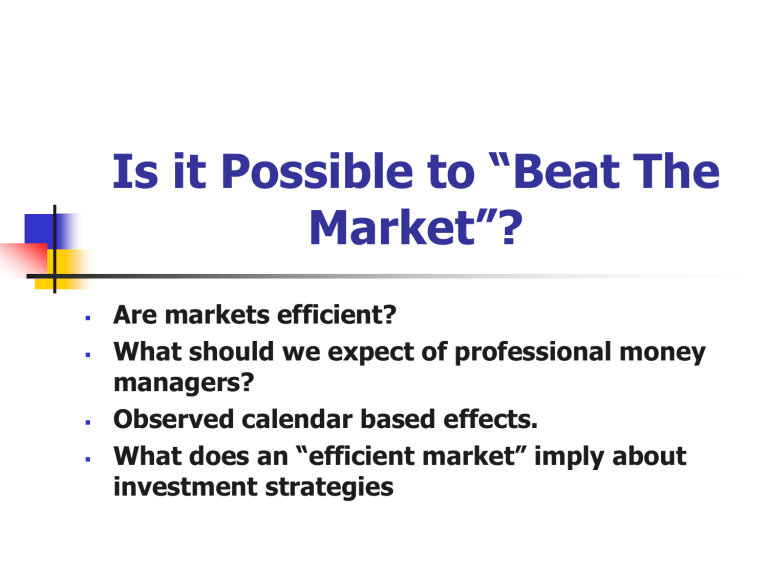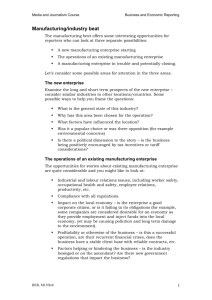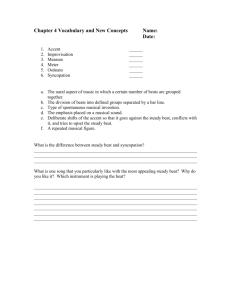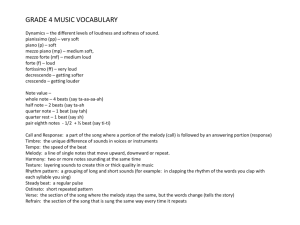Can you Beat the Market?
advertisement

Is it Possible to “Beat The Market”? Are markets efficient? What should we expect of professional money managers? Observed calendar based effects. What does an “efficient market” imply about investment strategies Market Efficiency The efficient market hypothesis (EMH) is a theory that asserts: As a practical matter, the major financial markets reflect all relevant information at a given time. Market efficiency research examines the relationship between stock prices and available information. The important research question: is it possible for investors to “beat the market?” Prediction of the EMH theory: if a market is efficient, it is not possible to “beat the market” (except by luck). What Does “Beat the Market” Mean? The excess return on an investment is the return in excess of that earned by other investments that have the same risk. “Beating the market” means consistently earning a positive excess return. Typically, we measure excess return for investment managers by comparing their returns to the “benchmark” index return, eg. a small cap investment manager to the Russell 2000 index. Some Implications of Market Efficiency: Random Walks and Stock Prices If you were to ask people you know whether stock market prices are predictable, many of them would say yes. To their surprise, and perhaps yours, it is very difficult to predict stock market prices. In fact, considerable research has shown that stock prices change through time as if they are random. That is, stock price increases are about as likely as stock price decreases. When there is no discernable pattern to the path that a stock price follows, then the stock’s price behavior is largely consistent with the notion of a random walk. Forms of Market Efficiency – what information is used? A Weak-form efficient market is one in which past prices and volume figures are of no use in beating the market. A Semi-strong-form efficient market is one in which publicly available information is of no use in beating the market. If so, then technical analysis is of little use. If so, then fundamental analysis is of little use. A Strong-form efficient market is one in which information of any kind, public or private, is of no use in beating the market. If so, then “inside information” is of little use. Why Would a Market be Efficient? The driving force toward market efficiency is simply competition and the profit motive. Even a relatively small performance enhancement can be worth a tremendous amount of money (when multiplied by the dollar amount involved). This creates incentives to unearth relevant information and use it. Does Old Information Help Predict Future Stock Prices? – Weak Form Efficiency This is a surprisingly difficult question to answer clearly. Researchers have used sophisticated techniques to test whether past stock price movements help predict future stock price movements. Some researchers have been able to show that future returns are partly predictable by past returns. BUT: there is not enough predictability to earn an excess return. Also, trading costs swamp attempts to build a profitable trading system built on past returns. Result: buy-and-hold strategies involving broad market indexes are extremely difficult to outperform. Technical Analysis implication: No matter how often a particular stock price path has related to subsequent stock price changes in the past, there is no assurance that this relationship will occur again in the future. Can Public Information be used to Beat the Market? – Semi-strong form efficiency We can test the impact of the release of public information on stock prices. New public information such as annual reports, dividend/earnings announcements, stock splits and political news. Semi strong form efficiency implies that trading rules based on fundamental analysis will not produce excess profits over a buy and hold strategy Strictly Financials 8 Informed Traders and Insider Trading – Strong form efficiency If a market is strong-form efficient, no information of any kind, public or private, is useful in beating the market. But, it is clear that significant inside information would enable you to earn substantial excess returns. This fact generates an interesting question: Should any of us be able to earn returns based on information that is not known to the public? Evidence about Market Efficiency Mutual Fund Performance Calendar Based Stock Returns Firm Size 10 Performance of Mutual Funds Mutual Fund Managers are often used to evaluate the performance of professional money managers 11 % of Mutual Funds that Beat the Vanguard 500 Index Fund – One year Returns % of Mutual Funds that Beat the Vanguard 500 Index Fund – Ten Year Returns Performance of Professional Money Managers over Various Holding Periods Professional Money Managers Don’t Show the Ability to “beat the market” Using one-year returns, in only 12 of the 24 years (1986—2009) did more than half beat the Vanguard 500 Index Fund. Using ten-year returns (1977-1986 through 20002009), in only 5 of these 24 investment periods did more than half the professional money managers beat the Vanguard 500 Index Fund. What’s more, other data show no consistency year to year in a fund’s relative performance Performance Anomalies Based on Time of the Year and Firm Size 16 The Day-of-the-Week Effect The day-of-the-week effect refers to the tendency for Monday to have a negative average return—which is economically significant. Interestingly, the effect is much stronger in the 1950-1979 time period than in the 1980-2009 time period. The “Month Effect” – Large Stocks The “Month Effect” – Small Stocks The “Turn-of-the-Month Effect” Turn of the month days = last day of one month through three days of next month “Turn of the Month” returns exceed “Rest of the Days” returns. The “Turn-of-the-Month” effect is apparent in all three time periods. Interestingly, the effect appears to be as strong in the 1986-2009 period than in the 1962-1985 period. The “Turn-of-the-Year” Effect Researchers look at returns over a specific threeweek period and compare these returns to the returns for the rest of the year. As shown on the next slide, we have calculated daily market returns from 1962 through 2009. “Turn of the Year Days:” the last week of daily returns in a calendar year and the first two weeks of daily returns in the next calendar year. “Rest of the Days:” Any daily return that does not fall into this three-week period. Measuring the “Turn-of-the-Year” Effect As you can see, the “Turn of the Year” returns are higher than the “Rest of the Days” returns. The difference is biggest in the 1962-1985 period. If Markets are Efficient …. How Should we Invest? 23 Implications of Market Efficiency for Investors Stock experts don’t have an advantage over amateurs because the competition is so severe Investment return will be a function of risk. The key factor in market efficiency is information. Most SEC regulation is designed to promote the flow of information to investors. Technical analysis is valueless because market participants already have incorporated any information contained in past price sequences into stock prices Strictly Financials 24 Implications (con’t) Fundamental analysis and brokerage firm recommendations will not enable you to identify firms which will outperform the market. Information contained in accounting statements and other public information already is reflected in security prices. It makes no sense to try and time the market. If markets can be “beaten” the way is not obvious. Strictly Financials 25 How Then Should We Invest? Buy and hold a well-diversified portfolio through time. Use low cost index Mutual Funds or ETFs Diversify across Stocks - Large cap, small cap, growth, value, international Fixed income – Treasuries, high yield, corporate, municipal Real Estate – REITs, direct investment funds MLPs – Transportation, E&P, Liquids, Storage Commodities – Ags, metals, oil and gas, Precious metals – Gold, silver Risk management tools – Options, futures Minimize fees, trading costs and expense ratios Minimize tax impacts of buying and selling. Rebalance periodically to your risk/reward target Strictly Financials 26 S&P 500 Pattern as of Friday* *Source: Larry McMillan, “The Options Strategist”, Oct 20, 2011 27






